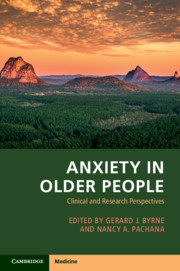Book contents
- Anxiety in Older People
- Anxiety in Older People
- Copyright page
- Contents
- Contributors
- Chapter 1 Introduction and Conceptual Overview
- Chapter 2 Epidemiology, Risk and Protective Factors
- Chapter 3 Diagnosis of Anxiety Disorders in Older Adults
- Chapter 4 Subthreshold Anxiety in Later Life
- Chapter 5 Cross-cultural Issues in Late-Life Anxiety
- Chapter 6 Clinical Assessment of Late-Life Anxiety
- Chapter 7 Late-Life Anxiety and Comorbid Depression
- Chapter 8 Anxiety and Cognitive Functioning
- Chapter 9 Anxiety in Parkinson’s Disease
- Chapter 10 Anxiety in Older Adults across Care Settings
- Chapter 11 Psychosocial Treatment of Anxiety in Later Life
- Chapter 12 Pharmacological Treatment of Anxiety in Later Life
- Chapter 13 Animal Models in Anxiety Research
- Chapter 14 Late-Life Anxiety
- Index
- References
Chapter 3 - Diagnosis of Anxiety Disorders in Older Adults
Published online by Cambridge University Press: 08 March 2021
- Anxiety in Older People
- Anxiety in Older People
- Copyright page
- Contents
- Contributors
- Chapter 1 Introduction and Conceptual Overview
- Chapter 2 Epidemiology, Risk and Protective Factors
- Chapter 3 Diagnosis of Anxiety Disorders in Older Adults
- Chapter 4 Subthreshold Anxiety in Later Life
- Chapter 5 Cross-cultural Issues in Late-Life Anxiety
- Chapter 6 Clinical Assessment of Late-Life Anxiety
- Chapter 7 Late-Life Anxiety and Comorbid Depression
- Chapter 8 Anxiety and Cognitive Functioning
- Chapter 9 Anxiety in Parkinson’s Disease
- Chapter 10 Anxiety in Older Adults across Care Settings
- Chapter 11 Psychosocial Treatment of Anxiety in Later Life
- Chapter 12 Pharmacological Treatment of Anxiety in Later Life
- Chapter 13 Animal Models in Anxiety Research
- Chapter 14 Late-Life Anxiety
- Index
- References
Summary
Debates about diagnosis in psychiatry and clinical psychology are both ever-present and controversial. They have recently gained greater prominence in the context of the publication of the fifth edition of the Diagnostic and Statistical Manual (DSM-5) of the American Psychiatric Association (2013). On the one hand, some authors are concerned that diagnostic processes impose unhelpful labels on human experience and lead to an over-reliance on their imperfect categories (Healy, 2011), while others suggest that the importance of diagnosis is growing rather than diminishing (Craddock & Mynors-Wallis, 2014). It is well documented that there are a number of features of anxiety disorders in older adults that pose specific challenges to both recognition and diagnosis (Bryant, 2010). This chapter considers some of the factors that make the diagnosis of anxiety disorders particularly complex in older adults.
- Type
- Chapter
- Information
- Anxiety in Older PeopleClinical and Research Perspectives, pp. 20 - 32Publisher: Cambridge University PressPrint publication year: 2021

